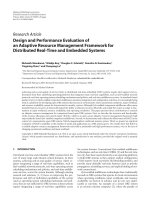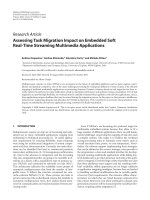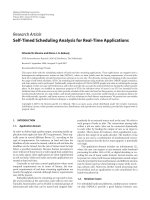Linux for embedded and real time applications
Bạn đang xem bản rút gọn của tài liệu. Xem và tải ngay bản đầy đủ của tài liệu tại đây (6.76 MB, 272 trang )
Linux for Embedded and
Real-time Applications
LICENSE INFORMATION: This is a single-user copy of this eBook. It may
not be copied or distributed.
Unauthorized reproduction or distribution of this eBook may result in severe criminal penalties.
.
Linux for Embedded and
Real-time Applications
by Doug Abbott
Amsterdam
Boston
London
San Diego
San Francisco
N e w Yo r k
Singapore
Oxford
Sydney
Paris
To k y o
Newnes is an imprint of Elsevier Science.
Copyright © 2003, Elsevier Science (USA). All rights reserved.
No part of this publication may be reproduced, stored in a retrieval system, or
transmitted in any form or by any means, electronic, mechanical, photocopying,
recording, or otherwise, without the prior written permission of the publisher.
Recognizing the importance of preserving what has been written,
Elsevier Science prints its books on acid-free paper whenever possible.
Library of Congress Cataloging-in-Publication Data
ISBN: 0-7506-7546-2
British Library Cataloguing-in-Publication Data
A catalogue record for this book is available from the British Library.
The publisher offers special discounts on bulk orders of this book.
For information, please contact:
Manager of Special Sales
Elsevier Science
200 Wheeler Road
Burlington, MA 01803
Tel: 781-313-4700
Fax: 781-313-4880
For information on all Newnes publications available, contact our World Wide
Web home page at:
10 9 8 7 6 5 4 3 2 1
Printed in the United States of America
Contents
Preface ................................................................................................... ix
Audience and Prerequisites ................................................................. x
Personal Biases .................................................................................. xi
Chapter 1: The Embedded and Real-time Space ..................................... 1
What Is Embedded? ........................................................................... 1
What Is Real-time? ............................................................................. 2
How and Why Does Linux Fit in? ........................................................ 3
Resources ........................................................................................... 7
Chapter 2: Introducing Linux ................................................................. 9
Features ............................................................................................. 9
Protected Mode Architecture ............................................................ 11
The Linux Process Model .................................................................. 16
The Linux Filesystem ......................................................................... 21
The “root” User ................................................................................ 23
The /usr hierarchy ............................................................................ 28
The Shell .......................................................................................... 29
Resources ......................................................................................... 29
Chapter 3: The Host Development Environment .................................. 31
Cross-Development Tools—the GNU Tool Chain ............................... 32
Configuring and Building the Kernel ................................................. 33
Summary ......................................................................................... 46
Resources ......................................................................................... 46
Chapter 4: BlueCat Linux ..................................................................... 49
The “Less Is More” Philosophy .......................................................... 49
Installing BlueCat Linux .................................................................... 50
X86 Target for Blue Cat Linux ........................................................... 52
v
Linux for Embedded and Real-time Applications
Configuring the Workstation ............................................................ 55
First Test Program ............................................................................ 58
Directories ....................................................................................... 58
Configuration Files ........................................................................... 59
Makefile ........................................................................................... 59
Target Files ....................................................................................... 59
Resources ......................................................................................... 63
Chapter 5: Debugging Embedded Software ......................................... 65
The Target Setup .............................................................................. 65
GDB ................................................................................................ 66
Debugging a Sample Program........................................................... 68
The Host as a Debug Environment .................................................... 73
Adding Programmable Setpoint and Limit ........................................ 76
Resources ......................................................................................... 79
Chapter 6: Kernel Modules and Device Drivers .................................... 81
Kernel Modules ................................................................................ 81
What’s a Device Driver Anyway? ........................................................ 86
Linux Device Drivers .......................................................................... 87
Internal Driver Structure ................................................................... 90
The Hardware .................................................................................. 95
The Target Version of Thermostat ..................................................... 96
Debugging Kernel Code .................................................................... 96
Building Your Driver into the Kernel ................................................ 100
An Alternative—uCLinux ................................................................. 103
Resources ....................................................................................... 104
Chapter 7: Embedded Networking ..................................................... 105
Sockets .......................................................................................... 105
A Simple Example ........................................................................... 108
A Remote Thermostat .................................................................... 111
Embedded Web Servers .................................................................. 113
Resources ....................................................................................... 116
vi
Contents
Chapter 8: Introduction to Real-time Programming........................... 117
Polling vs. Interrupts ....................................................................... 118
Tasks .............................................................................................. 125
Scheduling ..................................................................................... 128
Kernel Services................................................................................ 132
Inter-task Communication .............................................................. 134
Problems with Solving the Resource Sharing Problem—
Priority Inversion ............................................................................ 141
Interrupts and Exceptions ............................................................... 143
Critical Sections ............................................................................. 144
Resources ....................................................................................... 145
Chapter 9: Linux and Real-time .......................................................... 147
Why Linux Isn’t Real-time ............................................................... 147
Two Approaches ............................................................................ 150
Resources—Obtaining Real-time Linux Implementations .................. 153
Chapter 10: The RTAI Environment ................................................... 155
Installing RTAI................................................................................ 155
The RTAI Architecture .................................................................... 159
Intertask Communication and Synchronization ............................... 162
Communicating with Linux Processes .............................................. 163
Real-time in User Space—LXRT ....................................................... 164
One Shot vs. Periodic Timing .......................................................... 167
Moving to Kernel Space .................................................................. 170
Real-time FIFOs and Shared Memory .............................................. 171
Suggested Exercises ......................................................................... 173
Chapter 11: Posix Threads ................................................................. 175
Threads .......................................................................................... 176
Synchronization—Mutexes .............................................................. 178
Communication—Condition Variables............................................. 181
Pthreads in User Space ................................................................... 182
Moving to Kernel Space .................................................................. 188
Message Queues ............................................................................. 190
Suggestions for Further Exploration ................................................ 192
Resources ....................................................................................... 193
vii
Linux for Embedded and Real-time Applications
Appendix A: RTAI Application Programming Interface (API) ............. 195
Appendix B: Posix Threads (Pthreads) Application Programming
Interface ........................................................................................ 227
Appendix C: Why Software Should Not Have Owners ....................... 243
Index ................................................................................................... 251
viii
Preface
“ ’You are in a maze of twisty little passages, all alike’
Before you looms one of the most complex and utterly intimidating systems ever
written. Linux, the free UNIX clone for the personal computer, produced by a
mishmash team of UNIX gurus, hackers, and the occasional loon. The system
itself reflects this complex heritage, and although the development of Linux may
appear to be a disorganized volunteer effort, the system is powerful, fast, and
free. It is a true 32-bit operating system solution.”1
I have a confession to make. Until about three years ago, I didn’t like Unix
and avoided it as much as possible. I always considered it deliberately obscure
and difficult to use. I still do. Working with Linux has been one of the most
frustrating experiences in my long career as a computer engineer. I can do a
Windows installation in about 15 minutes without ever referring to a
manual. I can’t do that with Linux.
But, while Linux is far from being ready for prime time in the world of consumer computing, there are some good things about it that have forced me to
soften my bias and grin and bear it. In the embedded space where I work,
Linux can no longer be ignored or avoided, nor should it be.
Linux is indeed complex and, unless you’re already a Unix guru, the learning
curve is quite steep. The information is out there on the web but it is often
neither easy to find nor readable. There are probably hundreds of books in
print on Linux covering every aspect from beginners’ guides to the internal
workings of the kernel. But until recently little has been written about Linux
in embedded or real-time environments.
1
Linux Installation and Getting Started, Matt Welsh, et al.
ix
Linux for Embedded and Real-time Applications
I decided to climb the Linux learning curve partly because I saw it as an
emerging market opportunity and partly because I was intrigued by the Open
Source development model. The idea of programmers all over the world
contributing to the development of a highly sophisticated operating system
just for the fun of it is truly mind-boggling. Having the complete source code
not only allows you to modify it to your heart’s content, it allows you (in
principle at least) to understand how the code works. Unfortunately, my
experience has been that a lot of Linux code is “write-only.” Someone obviously wrote it, but no one else can read it.
Open Source has the potential to be a major paradigm shift in how our
society conducts business because it demonstrates that cooperation can be as
useful in developing solutions to problems as competition. Yet at the time
this book is being written, serious questions are being raised concerning
whether or not it is possible to actually make money with Open Source
software. Is there a business model that works? The jury is still out.
Audience and Prerequisites
This book is directed at two different audiences:
■
The primary audience is embedded programmers who need an introduction to Linux in the embedded space. This is where I came from
and how I got into Linux so it seems like a reasonable way to structure the book.
■
The other audience is Linux programmers who need an introduction
to the concepts of embedded and real-time programming.
Consequently, each group will see some material that is review although it
may be presented with a fresh perspective.
This book is not a beginners’ guide. I assume that you have successfully
installed a Linux system and have at least played around with it some. You
know how to log in, you’ve experimented with some of the command utilities
and have probably fired up X-windows. Chapter 2 is a cursory introduction to
some of the features and characteristics of Linux that are of interest to
embedded and real-time programmers.
x
Preface
The book is divided into two parts: Part I deals with Linux in the embedded
space, Part II looks at different approaches to giving the Linux kernel deterministic characteristics. It goes without saying that you can’t learn to
program by reading a book. You have to do it. That’s why this book is designed as a practical hands-on guide. The companion CD contains several
packages that we’ll explore in depth in the following chapters.
Embedded programming implies a target machine that is separate and distinct from the workstation development machine. We’ll look at two target
environments developing essentially the same projects on each.
■
The X86. More and more embedded projects are choosing the PC
architecture as a target platform. And of course Linux was originally
developed for the PC. For the purpose of this book, an x86 target
need be nothing more than an old 486 box gathering dust in your
closet.
■
Motorola Coldfire. The Coldfire processor is a variant on the 68000.
From the viewpoint of Linux, the interesting thing about the Coldfire
is that it lacks a memory management unit. This necessitates a modification to the kernel to fake out the memory protection mechanism.
A suitable Coldfire target board is available for a reasonable price
from Lineo, Inc. This is an example of a small processor suitable for
deeply embedded applications.
Personal Biases
Like most computer users, for better or worse, I’ve spent years in front of a
Windows screen. But before that I was perfectly at home with DOS and even
before that I hacked away at RT-11, RSX-11 and VMS. So it’s not like I don’t
understand command line programming. In fact it was probably a couple of
years before I finally added WIN to my AUTOEXEC.BAT file.
Hardcore Unix programmers think GUIs are for wimps. They proudly do
everything from the command line. Say what you will, but I like GUIs. Yes,
the command line still has its place, particularly for shell scripts and
makefiles, but for moving around the file hierarchy and doing simple file
xi
Linux for Embedded and Real-time Applications
operations like move, copy, delete, rename, etc, drag-and-drop beats the
miserably obscure Unix commands hands down. I also refuse to touch textbased editors like vi and emacs. Sure they’re powerful if you can remember all
the obscure commands. Give me a WYSIWYG editor any day.
My favorite GUI is the KDE desktop environment. It has all the necessary
bells and whistles including a very nice syntax coloring editor. KDE is included in most commercial Linux distributions. Clearly, you’re free to use
whatever environment you’re most comfortable with to work the book’s
examples. But if you’re new to Linux, I would recommend KDE.
OK, enough philosophizing. Let’s get on with it. Join me for a thrill-packed,
sometimes bumpy, but ultimately fun and rewarding, ride through those
twisty little passages known as Linux.
xii
1
CHAPTER
The Embedded and
Real-time Space
What Is Embedded?
You’re at a party when an attractive member of the opposite sex approaches
and asks you what you do. You could be flip and say something like “as little
as possible,” but eventually the conversation will get around to the fact that
you write software for embedded systems. Before your new acquaintance
starts scanning the room for a lawyer or doctor to talk to, you’d better come
up with a captivating explanation of embedded systems.
I usually start by saying that an embedded system is a device that has a
computer inside it, but the user of the device doesn’t necessarily know, or
care, that the computer is there. It’s hidden. The example I usually give is the
engine control computer in your car. You don’t drive the car any differently
because the engine happens to be controlled by a computer. In fact the
typical car today has more raw computing power than the Lunar Lander. You
can then go on to point out that there are a lot more embedded computers
out in the world than there are PCs—by at least an order of magnitude. The
average house contains perhaps a couple dozen computers even if it doesn’t
have a PC.
From the viewpoint of programming, embedded systems show a number of
significant differences from conventional “desktop” applications. For example, most desktop applications deal with a fairly predictable set of I/O
devices—a disk, graphic display, a keyboard, mouse, sound card, perhaps a
network interface. And these devices are generally well supported by the
1
Linux for Embedded and Real-time Applications
operating system. The application programmer doesn’t need to pay much
attention to them.
Embedded systems on the other hand often incorporate a wider variety of
input/output devices than typical desktop computers. A system may include
user I/O in the form of switches, pushbuttons and various types of displays. It
may have one or more communication channels, either asynchronous serial
or network ports. It may implement data acquisition and control in the form
of analog-to-digital (A/D) and digital-to-analog (D/A) converters. These
devices seldom have the kind of operating system support that application
programmers are accustomed to. The embedded systems programmer often
has to deal directly with the hardware.
What Is Real-time?
Real-time is harder to explain. The basic idea behind real-time is that we
expect the computer to respond to its environment in time. Many people
assume that real-time means real fast. Not true. Real-time simply means fast
enough in the context in which the system is operating. If we’re talking about
the computer that runs your car’s engine, that’s fast! That guy has to make
decisions—about fuel flow, spark timing—every time the engine makes a
revolution.
On the other hand, consider a chemical refinery controlled by one or more
computers. The computer system is responsible for controlling the process
and detecting potentially destructive malfunctions. But chemical processes
have a time constant in the range of seconds to minutes at the very least. So
we would assume that the computer system should be able to respond to any
malfunction in sufficient time to avoid a catastrophe. But suppose the computer were in the midst of printing an extensive report about last week’s
production when the malfunction occurred. How soon would it be able to
respond to the potential emergency?
The essence of real-time computing is not only that the computer responds
to its environment fast enough, but that it responds reliably fast enough. The
engine control computer must be able to adjust fuel flow and spark timing
2
The Embedded and Real-time Space
every time the engine turns over. If it’s late, the engine doesn’t perform right.
The controller of a chemical plant must be able to detect and respond to
abnormal conditions in sufficient time to avoid a catastrophe. If it doesn’t, it
has failed.
So the art of real-time programming is designing systems that reliably meet
timing constraints in the midst of random asynchronous events. Not surprisingly, this is easier said than done and there is an extensive body of literature
and development work devoted to the theory of real-time systems.
How and Why Does Linux Fit in?
By now just about everyone in the computer business knows the history of
Linux: how Linus Torvalds started it all back in 1991 as a simple hobby
project to which he invited other interested hackers to contribute. Back then
no one could have predicted that this amorphous consortium of volunteer
programmers and the occasional loon, connected only by the Internet, would
produce a credible operating system to compete with even the Borg of
Redmond.
Of course, Linux developed as a general-purpose operating system in the model
of Unix whose basic architecture it emulates. No one would suggest that Unix
is suitable as an embedded operating system. It’s big, it’s a resource hog and its
scheduler is based on “fairness” rather than priority. In short, it’s the exact
antithesis of an embedded operating system.
But Linux has several things going for it that earlier versions of Unix lack.
It’s free and you get the source code. There is a large and enthusiastic community of Linux developers and users. There’s a good chance that someone
else either is working or has worked on the same problem you’re facing. It’s
all out there on the web. The trick is finding it.
Open Source
Linux has been developed under the philosophy of Open Source software
pioneered by the Free Software Foundation. Open Source is based on the
notion that software should be freely available: to use, to modify, to copy.
3
Linux for Embedded and Real-time Applications
There are a number of misconceptions about the nature of Open Source
software. Perhaps the best way to explain what it is is to start by talking
about what it isn’t.
■
Open Source is not shareware. A precondition for the use of
shareware is that you pay the copyright holder a fee. Open source
code is freely available and there is no obligation to pay for it.
■
Open Source is not “public domain.” Public domain code, by definition, is not copyrighted. Open Source code is copyrighted by its
author who has released it under the terms of the GNU General
Public License (GPL). The copyright owner thus gives you the right
to use the code provided you adhere to the terms of the GPL.
■
Open Source is not necessarily free of charge. Having said that there’s
no obligation to pay for Open Source software doesn’t preclude you
from charging a fee to package and distribute it. A number of companies are in the specific business of selling packaged “distributions” of
Linux.
Why would you pay someone for something you can get for free? Presumably
because everything is in one place and you can get some support from the
vendor. Of course the quality of support greatly depends on the vendor.
So “free” refers to freedom to use the code and not necessarily zero cost.
Think “free speech,” not “free beer.”
Open Source code is:
■
Subject to the terms of the GNU Public License (see below).
■
Subject to critical peer review. As an Open Source programmer, your
code is out there for everyone to see and the Open Source community
tends to be a very critical group. Open Source code is subject to extensive testing and peer review. It’s a Darwinian process in which only the
best code survives. “Best” of course is a subjective term. It may be the
best technical solution but it may also be completely unreadable.
4
The Embedded and Real-time Space
■
Highly subversive. The Open Source movement subverts the dominant paradigm, which says that intellectual property such as software
must be jealously guarded so you can make a lot of money off of it. In
contrast, the Open Source philosophy is that software should be
freely available to everyone for the maximum benefit of society.
Richard Stallman, founder of the Free Software Foundation, is particularly vocal in advocating that software should not have owners
(see Appendix C).
Not surprisingly, Microsoft sees Open Source as a serious threat to its business model. Microsoft representatives have gone so far as to characterize
Open Source as “un-American.” On the other hand, many leading vendors of
Open Source software give their programmers and engineers company time
to contribute to the Open Source community. And it’s not just charity, it’s
good business.
The GNU Public License (GPL)
Open Source software is released according to the terms of the GNU Public
License, GPL. Unlike most End User License Agreements (EULA) for
software, whose motivation is to restrict your rights, the GPL is intended to
guarantee your rights to use, modify and copy the subject software. Along
with the rights comes an obligation. If you modify and subsequently distribute software covered by the GPL, you are obligated to make available the
modified source code. The changes become a “derivative work” which is also
subject to the terms of the GPL. This allows other users to understand the
software better and to make further changes if they wish.
This works well for most software but there is at least one problem. Suppose,
for example, that you write a clever application that you wish to keep proprietary. If you link it with a C library covered by the GPL, your application
becomes a derivative work and thus you’re required to distribute your source
code.
To get around this, and therefore promote the development of Open Source
libraries, the Free Software Foundation came up with the “Library GPL.” The
5
Linux for Embedded and Real-time Applications
distinction is that a program linked to a library covered by the LGPL is not
considered a derivative work and so there’s no requirement to distribute the
source, although you must still distribute the source to the library itself.
Subsequently, the LGPL became known as the “Lesser GPL” because it offers
less freedom to the user. So while the LGPL makes it possible to develop
proprietary products using Open Source software, the FSF encourages developers to place their libraries under the GPL in the interest of maximizing
openness.
Portable and Scalable
Linux was originally developed for the Intel x86 family of processors and
most of the ongoing kernel development work continues to be on x86s.
Nevertheless, the design of the Linux kernel makes a clear distinction between processor-dependent code that must be modified for each different
architecture, and code that can be ported simply by recompiling it. Consequently, Linux has been ported to a wide range of processor architectures
including:
■
Motorola 68k and its many variants
■
Alpha
■
Power PC
■
ARM
■
SPARC
■
MIPS
to name just a few. So whatever 32-bit architecture you’re considering for
your embedded project, chances are there’s a Linux port available for it and a
community of developers supporting it.
A typical desktop Linux installation runs into several hundred megabytes of
disk space and requires 32 megabytes of RAM to execute decently. By contrast, embedded targets are often limited to perhaps eight or 16 megabytes of
RAM and a few megabytes of ROM or flash. Fortunately, Linux is highly
6
The Embedded and Real-time Space
modular. Much of that several hundred megabytes represents documentation,
desktop utilities and options like games that simply aren’t necessary in an
embedded target. It is not difficult to produce a fully functional, if limited,
Linux system occupying no more than 2 megabytes of flash memory.
The kernel itself is highly configurable and includes reasonably user-friendly
tools that allow you to remove kernel functionality not required in your
application.
Resources
Linux resources on the web are extensive. This is a list of some sites that are
of particular interest to embedded developers.
linuxdevices.com – A news and portal site devoted to the entire range of issues
surrounding embedded Linux.
embedded-linux.org – The Embedded Linux Consortium, a nonprofit, vendorneutral trade association promoting Linux in the embedded space. Its
major effort at present is the development of an embedded Linux platform specification.
kernel.org – The Linux kernel archive. This is where you can download the
latest kernel versions as well as virtually any previous version.
sourceforge.net – “World’s largest Open Source development website.” Provides free services to open source developers including project hosting
and management, version control, bug and issue tracking, backups and
archives, and communication and collaboration resources.
embedded.com – The web site for Embedded Systems Programming magazine.
This site is not specifically oriented to Linux, but is quite useful as a more
general embedded information tool.
7
[This is a blank page.]
2
CHAPTER
Introducing Linux
Software is like sex, it’s better when it’s free.
— Linus Torvalds
For those who may be new to Unix-style operating systems, this chapter
provides an introduction to some of the salient features of Linux, especially
those of interest to embedded developers. This is by no means a thorough
introduction and there are many books available that delve into these topics
in much greater detail.
Feel free to skim, or skip this chapter entirely, if you are already comfortable
with Unix concepts.
Features
Here are some of the important features of Linux, and Unix-style operating
systems in general.
■
1
Multitasking – The Linux scheduler implements true, preemptive
multitasking in the sense that a higher priority process made ready by
the occurrence of an asynchronous event will preempt the currently
running process. However, the stock Linux kernel itself is not
preemptible1. So a process may not be preempted while it is executing
a kernel service. Some kernel services can be rather long and the
resulting latencies make standard Linux generally unsuitable for realtime applications.
Is it “preemptible” or “preemptable”? Word’s spelling checker says they’re both wrong. A
debate on linuxdevices.com a while back seemed to come down on the side of “ible” but
not conclusively. I think I’ll stick with preemptible.
9
Linux for Embedded and Real-time Applications
2
■
Multi-user – Unix evolved as a time-sharing system that allowed
multiple users to share an expensive (at that time anyway) computer.
Thus there are a number of features that support privacy and data
protection. Linux preserves this heritage and puts it to good use in
server environments.2
■
Multi-processing – Linux offers extensive support for true symmetric
multi-processing (SMP).
■
Protected Memory – Each Linux process operates in its own private
memory space and is not allowed to directly access the memory space
of another process. This prevents a wild pointer in one process from
damaging the memory space of another process. The errant access is
trapped by the processor’s memory protection hardware and the
process is terminated with appropriate notification.
■
Hierarchical File System – Yes, all modern operating systems—even
DOS—have hierarchical file systems. But the Linux/Unix model adds
a couple of nice wrinkles on top of what we’re used to with traditional
PC operating systems:
o
Links – A link is simply a file system entry that points to another
file rather than being a file itself. Links can be a useful way to
share files among multiple users and find extensive use in configuration scenarios for selecting one of several optional files.
o
Device-Independent I/O – Again, this is nothing new, but Linux
takes the concept to its logical conclusion by treating every
peripheral device as an entry in the file system. From an
application’s viewpoint, there is absolutely no difference between
writing to a file and writing to, say, a printer.
Although my experience in the embedded space is that the protection features, particularly file permissions, can be a downright nuisance.
10
Introducing Linux
Protected Mode Architecture
The implementation of protected mode memory in contemporary Intel
processors first made its appearance in the 80386. It utilizes a full 32-bit
address for an addressable range of 4 gigabytes. Access is controlled such that
a block of memory may be: Executable, Read only or Read/Write.
The processor can operate in one of four privilege levels. A program running at
the highest privilege level, level 0, can do anything it wants—execute I/O
instructions, enable and disable interrupts, modify descriptor tables. Lower
privilege levels prevent programs from performing operations that might be
“dangerous.” A word processing application probably shouldn’t be messing
with interrupt flags, for example. That’s the job of the operating system.
So application code typically runs at the lowest level while the operating
system runs at the highest level. Device drivers and other services may run at
the intermediate levels. In practice, however, Linux and most other operating systems for Intel processors only use levels 0 and 3. In Linux level 0 is
called “Kernel Space” while level 3 is called “User Space.”
Real Mode
To begin our discussion of protected mode programming in the x86, it’s useful
to review how “real” address mode works. Back in the late ‘70s when Intel
was designing the 8086, the designers faced the dilemma of how to access a
megabyte of address space with only 16 bits. At the time a megabyte was
considered an immense amount of memory. The solution they came up with,
for better or worse, builds a 20-bit (1 mega-byte) address out of two 16-bit
quantities called the segment and offset. Shifting the segment value four bits
to the left and adding it to the offset creates the 20-bit linear address (see
figure 2-1).
In real mode, x86 processors have four segment registers. Every reference to
memory derives its segment value from one of these registers. By default,
instruction execution is relative to the Code Segment (CS). Most data
references (MOV for example) are relative to the Data Segment (DS) and
instructions that reference the stack are relative to the Stack Segment (SS).
11
Linux for Embedded and Real-time Applications
15
Segment Registers
0
Segment
15
+
Shift 4 bits
0
CS:
DS:
SS:
ES:
Code
Data
Stack
Extra
Offset
19
0
Physical Address
Figure 2-1: X86 Real Mode Addressing
The Extra Segment (ES) is used in string move instructions and can be used
whenever an extra data segment is needed. The default segment selection
can be overridden with segment prefix instructions.
A segment can be up to 64 kilobytes long and is aligned on 16-byte boundaries. Programs less than 64 kilobytes are inherently position-independent
and can be easily relocated anywhere in the 1 megabyte address space. Programs larger than 64 kilobytes, either in code or data, require multiple
segments and must explicitly manipulate the segment registers.
Protected Mode
Protected mode still makes use of the segment registers, but instead of providing a piece of the address directly, the value in the segment register (now
called the selector) becomes an index into a table of segment descriptors. The
segment descriptor fully describes a block of memory including, among other
things, its base and limit (see Figure 2-2). The linear address in physical
memory is computed by adding the offset in the logical address to the base
contained in the descriptor. If the resulting address is greater than the limit
specified in the descriptor, the processor signals a memory protection fault.
A descriptor is an 8-byte object that tells us everything we need to know
about a block of memory.
12
Introducing Linux
Logical Address
Selector
Offset
Physical
Memor y
Limit
Linear
Address
+
Descr iptor
Base Address
Descr iptor Table
GDT or LDT
Figure 2-2: Protected Mode Address Calculation
Base Address[31:0] Starting address for this block/segment.
Limit[19:0] Length of this segment. This may be either the length in bytes
(up to 1 megabyte) or the length in 4 kilobyte pages. The interpretation is defined by the Granularity bit.
Type A 4-bit field that defines the kind of memory that this segment
describes
S
0 = This descriptor describes a “System” segment. 1 = This descriptor
describes a code or data segment.
DPL Descriptor Privilege Level. A 2-bit field that defines that minimum
privilege level required to access this segment.
P
Present. 1 = The block of memory represented by this descriptor is
present in memory. Used in paging.
G
Granularity. 0 = Interpret Limit as bytes. 1 = Interpret Limit as 4
kilobyte pages
Note that with the Granularity bit set to 1, a single segment descriptor can
represent the entire 4 gigabyte address space.
13









